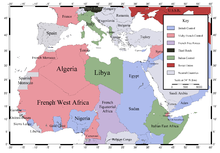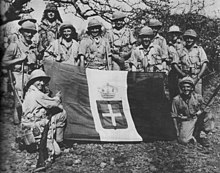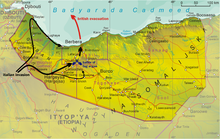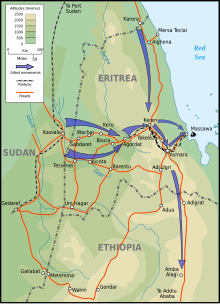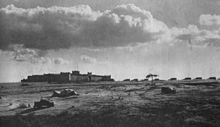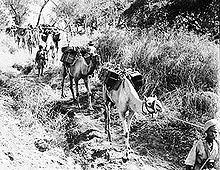East Africa campaign
The East African campaign is the name given to the hostilities during the Second World War in East Africa between the fascist Kingdom of Italy and the British Empire , which began in June 1940 with Italian attacks on the neighboring British colonies and ended in November 1941 with the defeat of the Italians in Italian East Africa . Troops from British India , South Africa and the other British colonies in Africa, as well as the Belgian Force Publique , fought under the command of the Middle East Command together with British, irregular Ethiopian , Free French units against the Italians and their local auxiliary troops, supported by a company of German Volunteer .
prehistory
With the victory over Emperor Haile Selassie of Abyssinia in the Italo-Ethiopian War of 1935–1936 , the fascist dictator Benito Mussolini had realized the long-cherished Italian dream of the Africa Orientale Italiana or Italian East Africa alongside the recently pacified Italian Libya . In the alliance with the National Socialist German Reich (“ Axis Berlin-Rome ” 1936) it was hoped to be able to consolidate and expand these positions vis-à-vis rivals France and Great Britain. In the immediate run-up to the Second World War triggered by the German invasion of Poland , the “ Steel Pact ” was tied even more closely to Germany in May 1939 .
With the British evacuation from Dunkirk and the impending fall of France in the western campaign , another reason for Italy to remain neutral was no longer available. On June 10, 1940, Mussolini declared war on France and Great Britain, attacked France on the Alpine border and bombed British bases in the Mediterranean.
Military starting position
In addition to the obvious goals of Egypt and Sudan to gain a land bridge to Libya and the isolated enclave of British Somaliland , British East Africa (now Kenya and Uganda ) and Tanganyika were tempting targets for the Italians. The Viceroy in East Africa, Amadeus, 3rd Duke of Aosta , had around 130,000 men at his disposal at the beginning of the war, 100,000 of whom were indigenous forced laborers, who were divided into four areas of command: one each for northern, southern and eastern Ethiopia and southern Somaliland. The size of the country and the need to maintain control and to defend the long border required the manning of widely scattered garrisons by small, mostly local troop contingents with Italian officers. For the guerrilla war, irregular local troops ( Italian gang ) were used. Larger reserves existed in central cities, including the Granatieri di Savoia division from the motherland and the Cacciatori d'Africa division, recruited from colonists . Reinforcements by troops and supplies from the motherland were not to be expected after the start of the war due to the strategic location of East Africa and the British control of the sea routes, especially the Suez Canal .
In contrast, Great Britain had only a few 10,000 men in the endangered colonies at the beginning of the war. However, the British Dominions and India had entered the war on the side of the motherland in 1939 and had their own expeditionary forces equipped and made available for use overseas. Parts of these troops were prepared in the Middle East for a possible deployment in Europe from the beginning of 1940, while others were supposed to strengthen the African colonies in the event that Italy entered the war. The 4th and 5th Divisions planned for Egypt were on the march from India, where the Australian and New Zealand troops also gathered. In East Africa two new black African divisions and the 1st South African division were set up. Furthermore, the establishment of associations from Ethiopian refugees was started. In this way, the previously unfavorable balance of power was almost compensated for by the end of 1940.
Initial stage of the fighting
The Italian chief of staff Pietro Badoglio had instructed the viceroy Amadeus, Duke of Aosta, to behave in a strictly defensive manner before hostilities broke out. Offensive operations should only be considered if the war situation develops favorably on other fronts.
Sudan and Kenya
Aosta prepared itself for an eventually expected British pincer attack from Sudan and Kenya. In the meantime, only minor Italian advances were carried out, the Italians occupied Kassala , Gallabat , Kurmuk and Qeisan on the border with Sudan and Moyale , Mandera , El Wak and Todenyang on the border with Kenya.
Invasion of British Somaliland
An obvious target for the Italians was the poorly defended and isolated British Somaliland . The British commander, Brigadier Arthur Reginald Chater , had only five battalions available to defend the colony. After Italy's armistice with France at the end of June, however, there was still a strong French garrison under General Paul Legentilhomme in neighboring French Somaliland (present-day Djibouti ) , which would likely side with the British in the event of an Italian attack. The situation was not cleared up until the end of July when General Germain, loyal to Vichy, was installed in Legentilhomme's place.
On August 3, 1940, the commander of the East Ethiopian command area, Lieutenant General Guglielmo Nasi, started the invasion with 25,000 men. The main goal was to capture the port city and capital of the Berbera colony . On August 5, the western Italian wing took Zeila on the border with French Somaliland, while the middle column took Hargeysa . The British commander then asked for reinforcements, but they did not arrive in time.
On August 11th, Major-General Alfred Reade Godwin-Austen took command of the British troops. On the same day, the battle began on the Tug Argan, a dry river bed near Adadle over which the road from Hargeysa to Berbera runs. Three days later, Godwin-Austen informed his superior in Cairo, General Henry Maitland Wilson , who was representing General Archibald Wavell at the time , of the hopelessness of the fight and asked for permission to evacuate his forces, which was given the next day. The evacuation from Berbera was completed on August 18 and the Italians entered the city the following day.
Mission No. 101 and Arbegnoch
On August 12, 1940, the British Colonel Daniel Sandford crossed the Sudanese-Ethiopian border to Gojjam with the order to win the local population for the fight against the Italians ( Mission No. 101 ). The dethroned Emperor Haile Selassie had already returned to Africa from Great Britain and set up his quarters in Khartoum at the beginning of July in preparation for his return to Ethiopia. With British help, he began to recruit Ethiopian refugees and exiles to set up an army. The name Arbegnoch ( Amharic for "patriots") was used for these troops, which were organized by Major Orde Wingate , and for the guerrilla fighters in Ethiopia.
After the arrival of the 5th Indian Division in Sudan in September, the British commander in Sudan, Lieutenant-General William Platt von Wavell, was given the task of preparing the reconquest of Gallabat and other border posts with them.
Khartoum Conference
On October 28, the day of the Italian attack on Greece , a conference began in Khartoum, attended by British War Minister Anthony Eden , South African Prime Minister Jan Christiaan Smuts , Emperor Haile Selassie and British Generals Wavell, Platt, Douglas P. Dickinson and His designated successor as Commander in British East Africa Alan Cunningham attended to discuss how to proceed. Wavell expressed the conviction that one now had sufficient troops for defense and that offensive operations could soon be carried out. Platt suggested starting operations on Kassala after the retaking of Gallabat in November. Dickinson wanted to operate in Kenya east of Lake Turkana because he did not have enough resources to attack Kismayo . Smuts spoke out in favor of linking the attack on Kassala with actions from Kenya, in particular to remove the threat to Mombasa from the Italians in southern Somaliland . Eden finally proposed planning the offensive against Kassala for January 1941 and making preparations for a simultaneous attack from Kenya.
Until the British offensive
The operation to retake Gallabat failed in November after initial successes. However, the overall strategic situation began to change after the devastating defeats of the Italians in Greece and Egypt (→ Operation Compass ). From mid-December, the battle-tested 4th Indian Division ( Noel Beresford-Peirse ) was moved from Egypt to Sudan to enable Platt to take an offensive approach. On December 16, a successful advance on El Wak on the Somali border was undertaken on the southern front . This and similar incidents made the Italians increasingly insecure. At the beginning of the new year there were increasing signs that the Italians would voluntarily evacuate Kassala. Aosta had decided, with Mussolini's consent, to limit its defense to the more advantageous highlands of Abyssinia and to abandon the border posts. He accepted the adverse effects of a withdrawal on the morale of the local troops.
The start of the British offensive from Sudan was set for January 19th. Cunningham, who originally wanted to wait for the rainy season to end, also felt able to take a more offensive approach than planned and was given permission to carry out his attack as far as Kismayo at the end of January.
However, the prospect of having to take action against a German attack on Greece soon prompted Wavell to be cautious. For the time being, he forbade Platt to extend his offensive to Ethiopia and warned that troops could be withdrawn from him again after the conquest of Eritrea. Cunningham was given permission to advance to Mogadishu if possible , but was also warned that the 1st South African Division could soon find other uses.
The British offensive against Italian East Africa
Campaign against Eritrea
On January 19, 1941, the two Indian divisions of Platts crossed the border with Eritrea. The Italians had already evacuated Kassala and retreated inland. Wavell then ordered Platt to follow suit, if possible to reach Asmara , the provincial capital. Towards the end of the month there were battles around Agordat and Barentu , in which the German Voluntary Motorized Company in Eritrea was also involved.
In early February, the two-month Battle of Keren began in the mountains northwest of Asmara , in which the resistance of the troops led by Nicolangelo Carnimeo , including parts of the Savoia division, was overcome after heavy fighting. Carnimeo surrendered on April 1st, and a week later the port city of Massaua , home port of the Italian flotilla in the Red Sea , was occupied. Their six destroyers had previously still a desperate attack on Port Sudan made being sunk by British aircraft, or by their own crews scuttled were not to fall into British hands. An Italian motor torpedo boat hit a torpedo on the cruiser HMS Capetown . On April 8, Rear Admiral Mario Bonetti surrendered with over 9,000 men and over 100 guns.
The commander of the Italian northern command Luigi Frusci had retreated south with the remains of his troops. It was followed by the 5th Indian Division, while the 4th Division was withdrawn to North Africa.
On April 11, US President Roosevelt canceled the declaration of the Red Sea and the Gulf of Aden as a war zone. This allowed neutral American ships to return to this route (which leads to the Suez Canal ).
French Somaliland, on the other hand, had been subject to a British blockade since the end of March, which was intended to induce troops loyal to Vichy to join the Forces françaises libres . This was more or less effectively maintained until March 1942.
Campaign in Somaliland and southern Ethiopia
At the end of January / beginning of February 1941, Cunningham's campaign across the Kenyan border began. He had three divisions: the 1st South African under George Brink and the 11th and 12th African. The 1st South African Division attacked Moyale while the two African divisions invaded Somalia. Their first goal was to capture the port of Kismayo, then to cross the Juba and advance to Mogadishu. The Italian resistance quickly collapsed and on February 25, Mogadishu was reached.
Aosta then instructed the local Italian commander Carlo De Simone to withdraw with his remaining troops to Jijiga . From there, at the end of March, they retreated further into the mountains towards Harar and Dire Dawa .
Operation Appearance , a sea-based landing operation against British Somaliland , began on March 16 . Two Indian Punjab battalions, which had been part of the defenders of British Somaliland the previous year, were crossed from Aden by Force D of the Royal Navy and took Berbera without resistance. Hargeysa was also liberated on March 20th. The operation greatly facilitated the supply of Cunningham's troops advancing from the south through the port of Berbera .
On April 6, after an eight-week campaign covering over 2,700 kilometers, the British captured Addis Ababa without resistance.
Gideon Force
Haile Selassie crossed the border into Ethiopia on January 20, accompanied by Wingate 's Gideon Force made up of Ethiopian volunteers and parts of the Sudan Defense Force , and initially moved into the advanced base of Sandford on Mount Belaya. Sandford was assigned to him as political and military advisor, and Wavell's chief political advisor, Philip Mitchell, took over the provisional administration of the liberated areas.
Wingate and his troops of fewer than 2,000 men successfully used guerrilla tactics to drive the Italians out of the area and pave the way for the emperor to enter Addis Ababa. On April 4, the provincial town of Debre Markos , protected by a group of forts, was captured after the Italians had withdrawn. The local ruler Ras Hailu Tekle Haymanot , who had previously supported the Italians, switched sides at this point. On the day of the fall of Addis Ababa, the emperor made his entry into Debre Markos and on May 5th he entered the capital.
Wingate achieved another great success at the end of May when he persuaded Colonel Maraventano with over 8,000 men to give up.
Battle of the Amba Alagi
Due to the seemingly hopeless situation, the Duke of Aosta left Addis Ababa to the north with some troops on April 3, to unite with the remnants of General Frusci's troops and to engage in a final battle on Mount Amba Alagi . Cunningham's offer to give up the fight in order to guarantee the safety of Italian civilians against attacks, he refused.
The 1st South African Brigade under Dan Pienaar had turned north a week after taking Addis Ababa in order to clear the road between Addis Ababa and Asmara in conjunction with Platt's troops. A little later, they took the important city of Dese , taking over 8,000 prisoners, most of them members of the Cacciatori d'Africa division .
The approximately 7,000 Italians under Aosta and Frusci held out at the Amba Alagi for two weeks against a superior force of the Indians and South Africans advancing from the north and south, until they capitulated on May 19.
Further operations
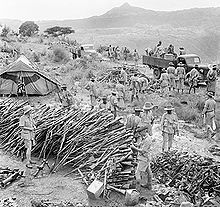
After the end of this battle only isolated groups of Italian troops remained in Ethiopia, among them the most important one in the province of Galla-Sidamo in the southwest under General Pietro Gazzera and one in Amara in the northwest under General Nasi. In the Eritrean port city of Assab there was still a small Italian garrison. The two black African divisions were considered sufficient by the British to take action against them and both the South African and the remaining Indian divisions were withdrawn for other uses.
From Addis Ababa, the African troops of Cunningham marched south through difficult terrain and with the onset of the rainy season and reached Shashemene in mid-May . Although Gazzera still had around 40,000 men, the morale of its troops was broken. The provincial capital Jimma was occupied without a fight on June 21. Gazzera finally surrendered on July 6 in the west of the province to the Belgian General Auguste-Éduard Gilliaert .
Until the surrender of Gazzera, mainly patriots, led by British officers, and parts of the Sudan Defense Force operated in the north-west of the country. Debre Tabor has been besieged by them since April and surrendered on July 6th after heavy air raids. The Wolchefit Pass, whose commander Colonel Gonella gave up on September 27th, was besieged for much longer. In the meantime, on September 15, the new East Africa Command had been set up under General Platt, who coordinated the further operations. The final attack on Gondar was scheduled for November after the end of the rainy season. Nasi capitulated on November 27th after the Battle of Gondar . This ended the East Africa campaign.
consequences
Remaining Italian forces led a guerrilla campaign in East Africa until the armistice with the Allies in 1943, led by officers such as Amedeo Guillet and Francesco De Martini .
French Somaliland was taken over by Free French troops in December 1942. Eritrea initially remained under British administration and became part of Ethiopia after the end of World War II. It gained its independence in 1993 after almost thirty years of civil war. Italian Somaliland remained under British control until 1949 when it was placed under Italian trusteeship by the United Nations . It became independent as Somalia in 1960 through the merger with British Somaliland .
literature
- Neil Orpen: East African and Abyssinian Campaigns. South African Forces World War II, Volume I. ( Online )
- ISO Playfair : The Mediterranean and Middle East, Volume I: The Early Successes against Italy (to May 1941). Her Majesty's Stationery Office, London 1954. ( Online )
- Ders .: The Mediterranean and Middle East, Volume II: The Germans come to the Help of their Ally (1941). Her Majesty's Stationery Office, London 1956. ( Online )
- Bisheshwar Prasad: East African Campaign, 1940-41. Official History of the Indian Armed Forces In the Second World War. Combined Inter-Services Historical Section (India & Pakistan), 1963. ( Online )
Web links
References and comments
- ^ Playfair: The Early Successes against Italy. P. 392 f.
- ^ Playfair: The Early Successes against Italy. P. 393 ff.
- ↑ Eritrea had been an independent colony until 1936, since then it has formed a province of Italian East Africa.
- ^ Playfair: The Early Successes against Italy. P. 396 .
- ↑ Playfair: The Germans come to the Help of their Ally. P. 322 ff.
- ^ Playfair: The Early Successes against Italy. P. 443 f.

